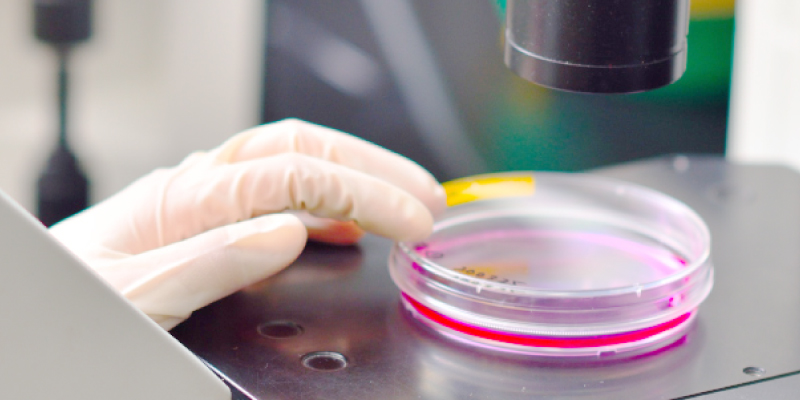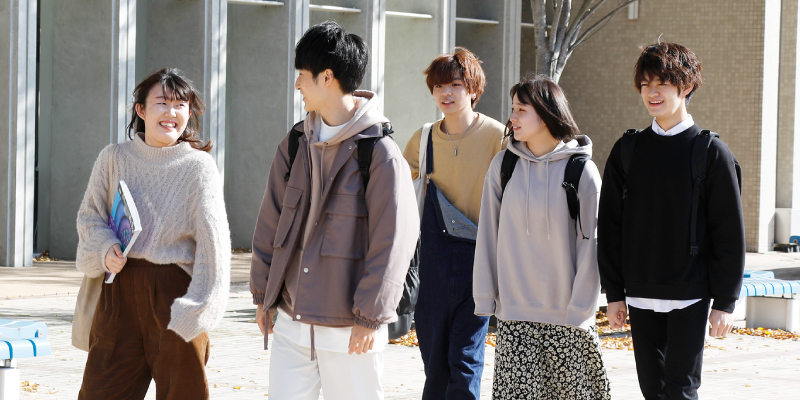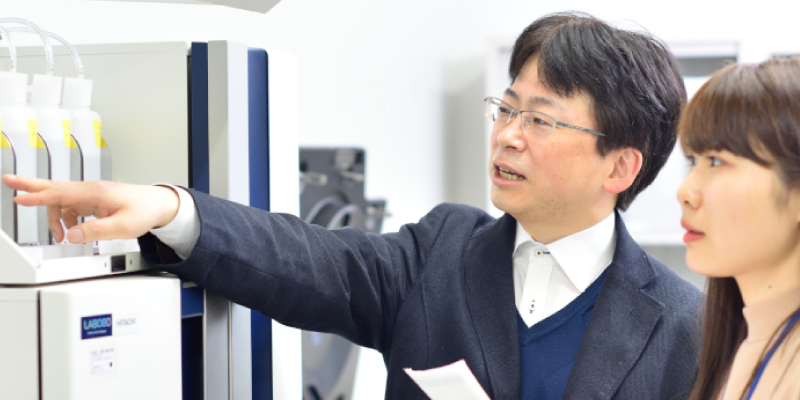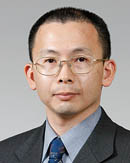
佐々木 真一
(ささき・しんいち)
Shin-ichi Sasaki
略歴
- 大阪大学大学院基礎工学研究科博士後期課程修了
- 慶應義塾大学理工学部応用化学科助手、立命館大学理工学部化学生物工学科助手を経て本学へ
光合成色素の合成的研究
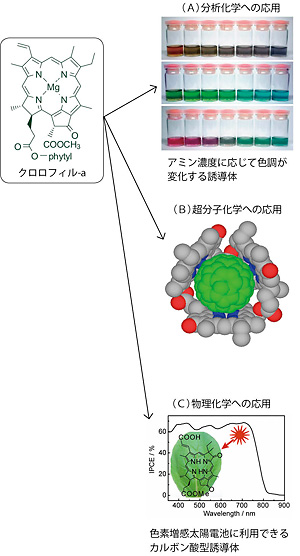
(1)センシング機能を有するクロロフィル誘導体の創製
(2)クロロフィルオリゴマーの創製と機能発現
(3)天然クロロフィル類を素材とする太陽電池用色素の創製
(4)その他
- 研究の応用領域
- 太陽エネルギー利用の新技術開発、環境関連物質の分析試薬開発
- 産官学連携で求めるパートナー
- 環境エネルギー関連企業、大学、国・地方自治体の研究機関
Chlorophyll(Chl)-a is the most abundant dye molecule in nature. Recent synthetic studies using Chl-a as a starting material include application towards sensing components in the field of analytical chemistry, sensitizers for solar cells, and construction of supramolecular structures for mimicking natural light-harvesting antennas.
1
Development of artificial chromoreceptors for the selective recognition of biologically important species has attracted much attention because of their possible application to chemical sensors such as optodes. As a first example of chemosensor using a chlorophyll derivative as a main dye unit, trifluoroacetyl-chlorins were developed for alcohol/ amine detection. The new chemosensors achieved guest sensing at a longer-wavelength region with less interference from environments and impurities.
2
In contrast to traditional silicon solar cells, most dye molecules applied in dye-sensitized solar cell lack lightharvesting ability in the near-infrared region. Because natural chlorophylls efficiently use a wide range of light energy, a series of chlorin derivatives applicable to electrodes have been designed and synthesized, and the relations between structural characteristics and the performance for solar cells have been studied.
3
In the initial stage of photosynthesis, dye molecules represented by chlorophylls are precisely arranged to form light-harvesting antennas, which enable absorption of sunlight, migration of harvested energy, and finally energy transfer to a reaction center. As artificial mimics of such antenna systems, covalently-linked cyclic chlorophyll oligomers as well as synthetic zinc chlorins possessing self-assembling abilities have been synthesized and their structural properties have been investigated.
M. Li, Na Li, W. Hu, G. Chen, S. Sasaki, K. Sakai, T. Ikeuchi, T. Miyasaka, H. Tamiaki, and X.-F. Wang: Effects of Cyclic Tetrapyrrole Rings of Aggregate- Forming Chlorophyll Derivatives as Hole-Transporting Materials on Performance of Perovskite Solar Cells. ACS Appl. Energy Mater., 1, 9-16 (2018).
Y. Sun, X.-F. Wang, G. Chen, C.-H. Zhan, O. Kitao, H. Tamiaki, and S. Sasaki: Near-Infrared Absorption Carboxylated Chlorophyll-a Derivatives for Biocompatible Dye-Sensitized Hydrogen Evolution. Int. J. Hydrogen Energy, 42, 15731-15738 (2017).
Y. Li, W. Zhao, M. Li, G. Chen, X.-F. Wang, X. Fu, O. Kitao, H. Tamiaki, K. Sakai, T. Ikeuchi, and S. Sasaki: Chlorophyll-Based Organic-Inorganic Heterojunction Solar Cells. Chem. Eur. J., 23, 10886-10892 (2017).
S. Duan, G. Chen, M. Li, G. Chen, X.-F. Wang, H. Tamiaki, and S. Sasaki: Near-Infrared Bacteriochlorophyll Derivatives as Biomaterial Electron Donor for Organic Solar Cells. J. Photochem. Photobiol. A Chem., 347, 49-54 (2017).
Y. Li, F. Zhang, X.-F. Wang, G. Chen, X. Fu, W. Tian, O. Kitao, H. Tamiaki, and S. Sasaki: Pluronic Micelle-Encapsulated Red-Photoluminescent Chlorophyll Derivative for Biocompatible Cancer Cell Imaging. Dyes Pigment., 136, 17-23 (2017).



